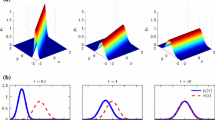Abstract
The identification of reduced-order models from high-dimensional data is a challenging task, and even more so if the identified system should not only be suitable for a certain data set, but generally approximate the input-output behavior of the data source. In this work, we consider the input-output dynamic mode decomposition method for system identification. We compare excitation approaches for the data-driven identification process and describe an optimization-based stabilization strategy for the identified systems.
Article PDF
Similar content being viewed by others
Avoid common mistakes on your manuscript.
References
Alla, A., Kutz, J.N.: Nonlinear model order reduction via dynamic mode decomposition. SIAM J. Sci. Comput. 39(5), B778–B796 (2017). https://doi.org/10.1137/16M1059308
Amsallem, D., Farhat, C.: Stabilization of projection-based reduced-order models. Numer. Methods Eng. 91(4), 358–377 (2012). https://doi.org/10.1002/nme.4274
Annoni, J., Gebraad, P., Seiler, P.: Wind farm flow modeling using input-output dynamic mode decomposition. In: American Control Conference (ACC), pp. 506–512 (2016). https://doi.org/10.1109/ACC.2016.7524964
Annoni, J., Seiler, P.: A method to construct reduced-order parameter-varying models. Int. J. Robust Nonlinear Control 27(4), 582–597 (2017). https://doi.org/10.1002/rnc.3586
Antoulas, A.C.: Approximation of Large-Scale dynamical systems, Adv. Des. Control, vol. 6. Society of Industrial and Applied Mathematics Publications, Philadelphia (2005). https://doi.org/10.1137/1.9780898718713
Aström, K.J., Eykhoff, P.: System identification – a survey. Automatica 7(2), 123–162 (1971). https://doi.org/10.1016/0005-1098(71)90059-8
Brunton, B.W., Johnson, L.A., Ojemann, J.G., Kutz, J.N.: Extracting spatial-temporal coherent patterns in large-scale neural recordings using dynamic mode decomposition. J. Neurosci. Methods 258, 1–15 (2016). https://doi.org/10.1016/j.jneumeth.2015.10.010
Burke, J.V., Overton, M.L.: Variational analysis of non-Lipschitz spectral functions. Math. Program. 90(2, Ser. A), 317–352 (2001). https://doi.org/10.1007/s102080010008
Chen, K.K., Tu, J.H., Rowley, R.W.: Variants of dynamic mode decomposition: boundary condition, Koopman, and Fourier analyses. Nonlinear Sci. 22(6), 887–915 (2012). https://doi.org/10.1007/s00332-012-9130-9
Curtis, F.E., Mitchell, T., Overton, M.L.: A BFGS-SQP method for nonsmooth, nonconvex, constrained optimization and its evaluation using relative minimization profiles. Optim. Methods Softw. 32(1), 148–181 (2017). https://doi.org/10.1080/10556788.2016.1208749
Fernando, K.V., Nicholson, H.: On the structure of balanced and other principal representations of SISO systems. IEEE Trans. Autom. Control 28(2), 228–231 (1983). https://doi.org/10.1109/TAC.1983.1103195
Holmes, P., Lumley, J.L., Berkooz, G., Rowley, C.W.: Turbulence, Coherent Structures, Dynamical Systems and Symmetry. Cambridge Monographs on Mechanics. Cambridge University Press, Cambridge (2012). https://doi.org/10.1017/CBO9780511919701
Ionescu, T.C., Fujimoto, K., Scherpen, J.M.A.: Singular value analysis of nonlinear symmetric systems. IEEE Trans. Autom. Control 56(9), 2073–2086 (2011). https://doi.org/10.1109/TAC.2011.2126630
Katayama, K.: Subspace Methods for System Identification. Communications and Control Engineering. Springer, London (2005). https://doi.org/10.1007/1-84628-158-X
Koopman, B.O.: Hamiltonian systems and transformation in Hilbert space. Proc. Natl. Acad. Sci. 17(5), 315–381 (1931). http://www.pnas.org/content/17/5/315.full.pdf
Kutz, J.N., Brunton, S.L., Brunton, B.W., Proctor, J.L.: Dynamic Mode Decomposition: Data-Driven Modeling of Complex Systems. Society of Industrial and Applied Mathematics, Philadelphia. https://doi.org/10.1137/1.9781611974508 (2016)
Lall, S., Marsden, J.E., Glavaški, S.: Empirical model reduction of controlled nonlinear systems. In: Proceedings of the IFAC World Congress, vol. F, pp. 473–478 (1999). https://doi.org/10.1016/S1474-6670(17)56442-3
Lewis, A.S., Overton, M.L.: Nonsmooth optimization via quasi-Newton methods. Math. Program. 141(1–2, Ser. A), 135–163 (2013). https://doi.org/10.1007/s10107-012-0514-2
Mezic, I.: Spectral properties of dynamical systems, model reduction and decompositions. Nonlinear Dyn. 41(1), 309–325 (2005). https://doi.org/10.1007/s11071-005-2824-x
Mitchell, T.: GRANSO: GRadient-based Algorithm for Non-Smooth Optimization. http://timmitchell.com/software/GRANSO. See also [10]
Nocedal, J., Wright, S.J.: Numerical Optimization. Springer, New York (1999). https://doi.org/10.1007/b98874
Oku, H., Fujii, T.: Direct subspace model identification of LTI systems operating in closed-loop. In: 43Rd IEEE Conference on Decision and Control, pp. 2219–2224 (2004). https://doi.org/10.1109/CDC.2004.1430378
Proctor, J.L., Brunton, S.L., Kutz, J.N.: Dynamic mode decomposition with control. SIAM J. Appl. Dyn. Syst. 15(1), 142–161 (2016). https://doi.org/10.1137/15M1013857
Proctor, J.L., Brunton, S.L., Kutz, J.N.: Generalizing Koopman Theory to Allow for Inputs and Control. arXiv:1602.07647, Cornell University. 1602.07647. Math.OC (2016)
Rowley, C.W., Dawson, S.T.M.: Model reduction for flow analysis and control. Annu. Rev. Fluid Mech. 49, 387–417 (2017). https://doi.org/10.1146/annurev-fluid-010816-060042
Rowley, C.W., Mezic, I., Bagheri, S., Schlatter, P., Henningson, D.S.: Spectral analysis of nonlinear flows. J. Fluid Mech. 641, 115–1127 (2009). https://doi.org/10.1017/S0022112009992059
Schmid, P.J.: Dynamic mode decomposition of numerical and experimental data. J. Fluid Mech. 656, 5–28 (2010). https://doi.org/10.1017/S0022112010001217
Tu, J.H., Rowley, C.W., Luchtenburg, D.M., Brunton, S.L., Kutz, J.N.: On dynamic mode decomposition: Theory and applications. J. Comput. Dyn. 1(2), 391–421 (2014). https://doi.org/10.3934/jcd.2014.1.391
Van Den Hof, P.M.J., Schrama, R.J.P.: An indirect method for transfer function estimation from closed loop data. Automatica 29(6), 1523–1527 (1993). https://doi.org/10.1016/0005-1098(93)90015-L
Van Overschee, P., De Moor, B.: N4SID: Numerical algorithms for state space subspace system identification. In: IFAC Proceedings Volumes, vol. 26, pp. 55–58 (1993). https://doi.org/10.1016/S1474-6670(17)48221-8
Viberg, M.: Subspace-based methods for the identification of linear time-invariant systems. Automatica 31(12), 1835–1851 (1995). https://doi.org/10.1016/0005-1098(95)00107-5
Acknowledgements
Open access funding provided by Max Planck Society. The authors are grateful for the helpful feedback and comments provided by the two anonymous referees.
Author information
Authors and Affiliations
Corresponding author
Additional information
Communicated by: Karsten Urban
Supported by the German Federal Ministry for Economic Affairs and Energy (BMWi), in the joint project: “MathEnergy – Mathematical Key Technologies for Evolving Energy Grids”, sub-project: Model Order Reduction (Grant number: 0324019B).
Rights and permissions
Open Access This article is distributed under the terms of the Creative Commons Attribution 4.0 International License (http://creativecommons.org/licenses/by/4.0/), which permits unrestricted use, distribution, and reproduction in any medium, provided you give appropriate credit to the original author(s) and the source, provide a link to the Creative Commons license, and indicate if changes were made.
About this article
Cite this article
Benner, P., Himpe, C. & Mitchell, T. On reduced input-output dynamic mode decomposition. Adv Comput Math 44, 1751–1768 (2018). https://doi.org/10.1007/s10444-018-9592-x
Received:
Accepted:
Published:
Issue Date:
DOI: https://doi.org/10.1007/s10444-018-9592-x




